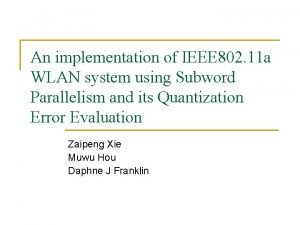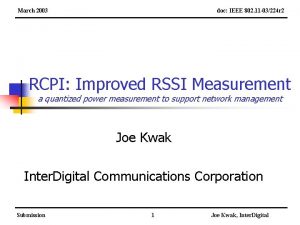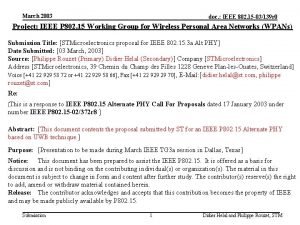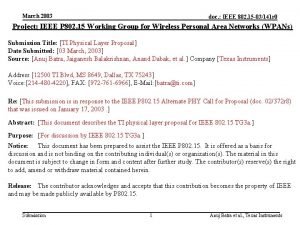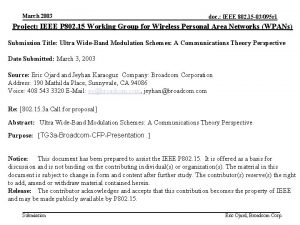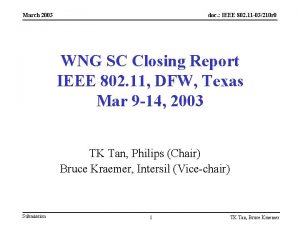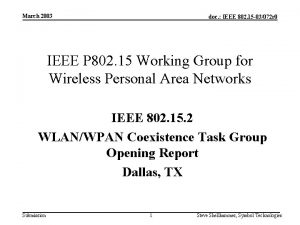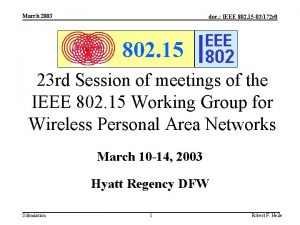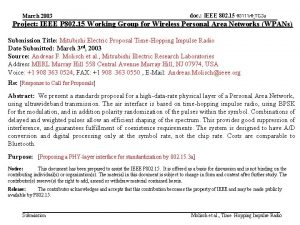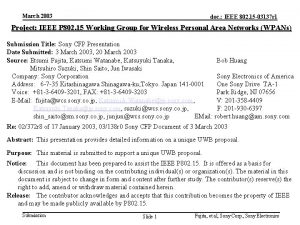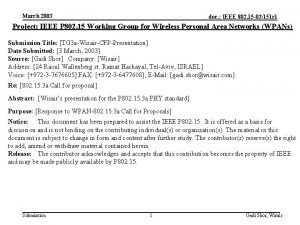March 2003 doc IEEE 802 11 03224 r












- Slides: 12

March 2003 doc: IEEE 802. 11 -03/224 r 1 RCPI: Improved RSSI Measurement a quantized power measurement to support network management Joe Kwak Inter. Digital Communications Corporation Submission 1 Joe Kwak, Inter. Digital

March 2003 doc: IEEE 802. 11 -03/224 r 1 Outline n n Need for improved RSSI measurement RSSI Limitations RCPI Specification details Open Issues Submission 2 Joe Kwak, Inter. Digital

March 2003 doc: IEEE 802. 11 -03/224 r 1 802. 11 defined PHY Measurements n n n TGK is tasked with providing new interfaces, new measurements, and mechanisms to support higher layer functions for efficient network management. 802. 11 currently has several PHY measurements, none of which seem suitable for handoff or network management purposes. RSSI: reportable parameter for each received frame, but unquantized and not fully specified. Can be used to compare frames from different AP sources. SQ: another unquantized indicator of code sync, but applicable only to DSSS PHY. RPI histogram: quantized and specified, but measures channel power from all sources: 802. 11 x, radars, and other interferers. Cannot target measurement on any AP using particular PHY. Submission 3 Joe Kwak, Inter. Digital

March 2003 doc: IEEE 802. 11 -03/224 r 1 Network Management Needs Comparative PHY (clauses 15, 17, 18, 19) Measurements 1. To compare power levels on same channel, same PHY, in same STA 2. To compare power levels on same channel, same PHY, in different STAs 3. To compare power levels on different channels, same PHY, in same STA 4. To compare power levels on different channels, same PHY, in different STAs 5. To compare power levels on different PHYs in different STAs 6. To compare power levels on different PHYs in same STA Comparative measurements are crucial to QOS and handoff decisions for Network Management, as discussed at Tutorial at last meeting. Comparative measurements are important for load management and interference mitigation. RSSI, as currently defined, only addresses needs #1 and #3. Submission 4 Joe Kwak, Inter. Digital

March 2003 doc: IEEE 802. 11 -03/224 r 1 RSSI definitions in 802. 11 n n n 15. 4. 5. 10. 2 PMD_RSSI. indicate(RSSI): The RSSI shall be a measure of the RF energy received by the DSSS PHY. RSSI indications of up to 8 bits (256 levels) are supported. 17. 2. 3. 2 RXVECTOR RSSI: The allowed values for the receive signal strength indicator (RSSI) parameter are in the range from 0 through RSSI maximum. This parameter is a measure by the PHY sublayer of the energy observed at the antenna used to receive the current PPDU. RSSI shall be measured during the reception of the PLCP preamble. RSSI is intended to be used in a relative manner, and it shall be a monotonically increasing function of the received power. 17. 5. 5. 7. 2 PMD_RSSI. indicate: This primitive shall provide the following parameters: PMD_RSSI. indicate(RSSI) The RSSI shall be a measure of the RF energy received by the OFDM PHY. RSSI indications of up to eight bits (256 levels) are supported. 18. 4. 5. 11. 2 PMD_RSSI. indicate: This primitive provides RSSI parameter as 0– 8 bits of RSSI. The RSSI is a measure of the RF energy received by the High Rate PHY. 19. 2 RSSI: The RSSI is a measure of the RF energy received by the ERP. The value depends on the value of the MODULATION parameter: n CCK, ER-PBCC: the 8 bit value of RSSI as described in 18. 4. 5. 11. n ERP-OFDM, DSSS-OFDM, the 8 bit value is in the range of 0 to RSSI maximum as described in 17. 2. 3. 2. Submission 5 Joe Kwak, Inter. Digital

March 2003 doc: IEEE 802. 11 -03/224 r 1 RSSI Limitations n n n In high interference environments, RSSI is not an adequate indicator of desired signal power level, since it indicates the sum of desired signal + noise + interference powers. RSSI is not fully specified: no unit definitions, no performance requirements (accuracy, fidelity, testability). Since so little about RSSI is specified, it must be assumed that widely variant implementations already exist. It is not possible to compare RSSIs from different STAs and perhaps not even from different channels/PHYs within same STA. RSSI may have limited use for relative power levels within a STA and within a given PHY, but not between PHYs. RSSI is rescaled between DSSS and OFDM PHYs. RSSI is clearly not useable by network management for handoff or load balancing. RSSI from one STA does not relate to RSSI from any other STA. Proposed RCPI overcomes these limitations by providing a quantized, comparative measure of power level for all channels/rates and among all PHYs and STAs. Submission 6 Joe Kwak, Inter. Digital

March 2003 doc: IEEE 802. 11 -03/224 r 1 Options for PHY measurements AGC B A Radio front end [Rx BW filter] A/D Demodulator and tracking loops (PHY specific) FEC Decoder (optional) D Frame Check (CRC) A: RF power, RF S/(N+I) from each AP C&D: Bit Error Rate (BER) @each data rate B: BB S/(N+I) from each AP, E: Frame Error Rate (FER) @each data rate (BB power constant by AGC) n C E Desired Input Power level at A (antenna connector) is normally measured indirectly by AGC value used for front end gain control. Submission 7 Joe Kwak, Inter. Digital

March 2003 doc: IEEE 802. 11 -03/224 r 1 Specified 802. 11 PHY Dynamic Ranges n n n Defined from Minimum Sensitivity Level at minimum data rate (low end of range) to Maximum Input Level (high end of range). Clause 15: -80 to -4 d. Bm for baseline DSSS Clause 17: -82 to -30 d. Bm for 11 a OFDM Clause 18: -76 to -10 d. Bm for 11 b DSSS Clause 19: -82 to -20 d. Bm for 11 g OFDM/DSSS Superset range is from -82 to -4 d. Bm Submission 8 Joe Kwak, Inter. Digital

March 2003 doc: IEEE 802. 11 -03/224 r 1 Received Channel Power Indication (RCPI) n n n Specified like RSSI: 8 -bit unsigned value, monotonically increasing with increasing signal strength. RCPI shall be logarithmically scaled in d. B to total received power within defined channel bandwidth at the antenna connector. Includes signal, noise, interference, and impairments. RCPI values shall be quantified in d. Bm and accuracy shall be specified across entire RCPI range. The 256 RCPI values shall range from -110 d. Bm to 0 d. Bm with 2 units per d. B. RCPI accuracy shall be +/- 5 d. B across the defined range, equivalent to accuracy specified by TGH for RPI histogram. Submission 9 Joe Kwak, Inter. Digital

March 2003 doc: IEEE 802. 11 -03/224 r 1 Draft Normative Text (add as para 18. 4. 5. 16 titled “PMD_RCPI. indicate”) n n RCPI: The RCPI indicator is a measure of the received RF power in the selected channel, measured at the antenna connector. This parameter shall be a measure by the PHY sublayer of the received RF power in the channel measured over the current frame. RCPI shall be measured over an entire received frame. RCPI shall be a monotonically increasing, logarithmic function of the received power level defined in d. B. The allowed values for the Received Channel Power Indicator (RCPI) parameter shall be an 8 bit value in the range from 0 through 255, with indicated values rounded to the nearest. 25 d. B as follows: n 0: Power < -110 d. Bm n 1: Power = -109. 5 d. Bm n 2: Power = -109. 0 d. Bm and so on n 220: Power > -0 d. Bm n 221 -255: reserved Accuracy for each measurement shall be +/- 5 d. B. The measurement shall assume a receiver noise equivalent bandwidth of 22 MHz. Submission 10 Joe Kwak, Inter. Digital

March 2003 doc: IEEE 802. 11 -03/224 r 1 RCPI May Supercede RSSI in Existing Specs n n n The definition of RCPI meets the requirements for RSSI: n 8 -bit unsigned value n Monotonically increasing function of received signal power TGK may specify that for STAs which comply with 802. 11 K, STAs may report RCPI (or PSNI) in any data field calling for RSSI. A new SME control variable could specify the use of the RSSI field: a) for RCPI, b) for PSNI, or c) for RSSI and so on. This makes the RCPI, and other new indicators, broadly reported and broadly applicable as frame quality measurements useful for all PHYs and STAs. Submission 11 Joe Kwak, Inter. Digital

March 2003 doc: IEEE 802. 11 -03/224 r 1 Tasks for Next Meeting n n n Integrate normative text into new TGK draft spec. Discuss Nomenclature options RCPI vs RSPI vs others. Discuss RCPI accuracy spec: +/- 20 units == +/- 5. 0 d. B. Consider various receiver filter BW implementations on new RCPI measurement. Consider advanced antenna designs with respect to new RCPI measurement Consider feedback, criticism and alternate draft specification wording. Submission 12 Joe Kwak, Inter. Digital












